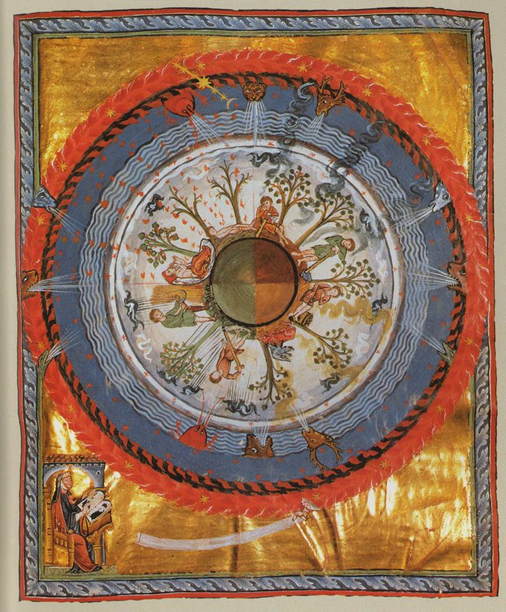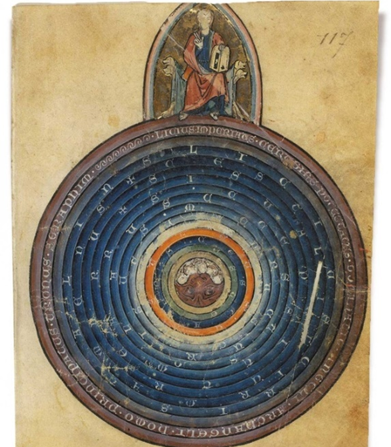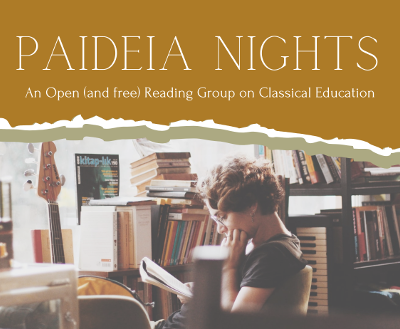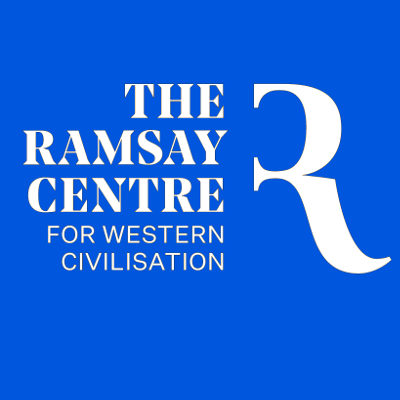This paper will concern itself with three teaching techniques for the classical classroom. These three have been selected because they are easy to learn – but difficult to master; they can implemented in all age groups from K to 12. They can be used in almost every subject area. They are high impact: high impact for the students but also high impact for the teacher, in opening one’s eyes to a different way of teaching.
This entry is Part Two of a three-part article. For Part One, visit this page.
The Middle Ages

HILDEGARD OF BINGEN. Cultivating the Cosmic Tree, 12th century.
The image above is an illustration by St Hildegard of Bingen, showing the kind of cosmic significance the medieval mind afforded the cycles and harmony found in the seasons, the earth, and the heavens (Hicks, 2021). But as we shall see, though Hildegard was clearly a genius and an outlier, this cosmic harmony was perceived to a far greater degree by the medieval perspective in general (Pennick, 1992).
We’ve already established that mankind has a hunger for the transcendent, but we also have a need to respond to that transcendence, to harmonise ourselves to it. These are three examples of these endeavours. The first one, the music of the spheres, is in fact Pythagorean but it comes to an especial importance in the Middle Ages.
 The Music of the Spheres were understood as the inaudible harmonies produced by the ordered movement of the heavenly bodies, a reminder that creation itself was structured by number and proportion, and that man should tune his soul to this eternal music (Walker, 1993; Hicks, 2021).
The Music of the Spheres were understood as the inaudible harmonies produced by the ordered movement of the heavenly bodies, a reminder that creation itself was structured by number and proportion, and that man should tune his soul to this eternal music (Walker, 1993; Hicks, 2021).
The significance of the Cathedrals is tied to an attempt to sanctify the earth to this harmony: rising like mountains of stone, their sacred geometry, stained glass, and chants embodied the conviction that earthly architecture and worship should mirror the order of heaven (Pennick, 1992; Hicks, 2021). And the prayers occurred within, marking Sunday as the Lord’s Day, fasting on Friday, marking the passing hours with the Liturgy of the Hours, and the days with the liturgical calendar. Here time and space were sanctified.

The Rota Fortunae, or Wheel of Fortune, as described by Boethius, also applied this harmonisation to the relative instability of human life, teaching that while Fortune’s wheel turns, the wise man orients himself to the unchanging transcendent centre—God—with the aid of Lady Philosophy (Boethius, n.d./Watts, 1999).

Rhythm vs. Algorithm
Much like the fact that character formation takes place in our schools whether we take an active part or not, you know, for better or worse. So too does a kind of cosmic rhythm take root in our children, for better or worse.
For much of this generation I would argue the axis mundi for their cosmos is their smart phone, it contains their entertainment, news, social connection, their vision of reality and it also sets the rhythm of their lives. They are feed by an algorithm rather than a true cosmic rhythm, and so we have the old that want to be eternally young, we have the young that want to old, we have boys that want to be girls and vice versa.
They do not wake up with the morning lark or the cry of a rooster they are summoned by the cool pale light of their phones each morning, and they do not get tired when the sun sets. Their phones choose when they sleep, it is their sun and their moon, the algorithms chooses when your children can stop consuming, when they can rest. And there is no rest, there is no Sabbath, there is no leisure in the view of Josef Pieper, there is no freedom as sought in the ideal of the liberal arts.
Paraphrasing Hopkins, they cannot feel the “dearest freshness deep down things” for their feet are shod. I had to remind my students that autumn follows Summer the other day – they are truly disconnected from the birds, the trees, the cycles of the seasons, the stars, from each other, so essentially divorced from romance and enchantment.
So what pedagogical principle does this boil down to, and what classroom technique can amend these ills?
The cosmos rests upon deep harmonies and our classroom must reflect this.
And a technique which helps our classrooms reflect cosmic harmony is a technique called the Class Catechism.
The Class Catechism
A Class Catechism is a recitation done by the whole class in the form of questions and answers, the teacher reads the question and the students answer it. Its read at the start of the lesson, preferably every lesson, and it should last from 4-6 minutes. The questions are best as deep, philosophical, and pondersome, and related to a general theme for the year or for the units of the year. The answers should be a bit above their reading level and a bit above their understanding, if its too easy this will be boring, the meaning needs to unfold over the course of weeks and months.

For this catechism the theme was ‘Moments of Discovery’ and I’d like to do just the first part together so we can get an idea of the experience. And the timing might be good as we have been sitting down for a while, so can I ask if it is comfortable for you to do so to stand up while we recite the catechism.
As the teacher I would ask the question: Why is the world full of discoveries?
And the students would answer:
The world is charged with the grandeur of God.
It will flame out, like shining from shook foil;
It gathers to a greatness, like the ooze of oil Crushed.
Why do men then now not reck his rod?
Generations have trod, have trod, have trod;
And all is seared with trade; bleared, smeared with toil;
And wears man's smudge and shares man's smell:
the soil Is bare now, nor can foot feel, being shod.
And for all this, nature is never spent;
There lives the dearest freshness deep down things;
And though the last lights off the black West went
Oh, morning, at the brown brink eastward, springs —
Because the Holy Ghost over the bent World
broods with warm breast and with ah! bright wings.
Many students have not really learnt anything by heart, in fact what you will find is that most will forget the majority of what they have learnt after they have finished the topic test.
After the initial speedbump of getting used to doing it, they will begin to like it – they will feel a part of something bigger than themselves. They will feel reharmonised and settled, they will feel the flow of the Great Conversation by the quality of the texts you choose. After doing this catechism for 6 months I heard at lunch time several 14 year olds reciting Emily Dickinson and William Blake and Rumi out in the yard – for fun! I talked at the start about how I’ve failed to teach classically but when I heard those students reciting those poems with mirth and music in their voices it made it all worth it. I had given around 50 Year 9 students something beautiful for life.
I did receive some poor feedback from this, not from the students but from leaders who did not understand its pedagogical nature. The given reason was the students would not like it and it seemed like brainwashing.
What was annoying is that the catechism is essentially dialogic (Gibbs 2019), that students do not need to agree with the poets, the authors, the philosophers, or saints whose words they are reading. In fact in most of the catechisms I have compiled, the authors don’t agree amongst themselves. So agreement is not needed but they do need to grapple with it. If they wish to disagree then the eloquence and strength of their disagreement will improve, if they agree their agreement will grow in nuance.
In reality what a catechism does is protect against is the repetitive brainwashing they are already receiving, in the lyrics of the vulgar songs they hear, the looping shorts on YouTube and TikTok which are rewiring their brains.

You can also build catechisms around historical or scientific themes as well.
I have also found through a slight adaptation, a way to bring in a view of natural and cosmic harmony. I would get 3 students up in the morning homeroom class make historical announcements of events that occurred on this day, this was at a Catholic school so any ecclesial announcements were fairly straightforward to determine, and a natural announcements. As well as giving students small stakes public speaking experience, we find a kind of harmony between the three as well. We learn about about the life of Saint Valentine, and about the kind of flowers that are in bloom, if any planets are visible at the moment. The class that I did this with were badly behaved on occasion and I found them much easier to manage when I did this, though I did not notice it right away. I did notice it when I stopped doing the calendar announcements though and found the bad behaviour increased, the cosmic harmony was not addressed and so there was discord. That’s my theory I don’t have any hard proof of that but it’s a strong hunch. And it’s a hunch connected a popular liberal arts program in the US, the Integrated Humanities Program run by John Senior at Kansas University – where the two most popular extracurricular voluntary activities were waltzing and star gazing. Talk about a cyclical or circular motif. And my students were also very keen to get pictures of eclipses and various visible planets in their own free time as well.
Now moving forward in time the next stage we will explore is the Renaissance.






